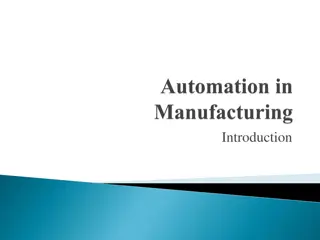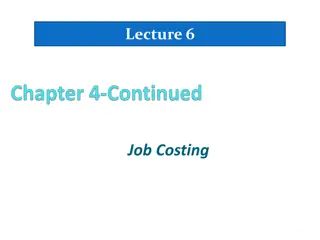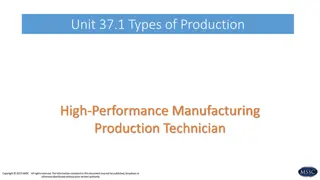Evolution of US Manufacturing: From Pre-WW2 to Post-WW2
Explore the historical journey of US manufacturing, from its focus on consumer goods before WW2 to its crucial role in wartime production during WW2. Witness the shifts post-WW2, including the decline in Defense Industrial Base connections. Understand the current challenges and the vital role of a robust manufacturing workforce in supporting national defense. Discover the significance of programs like the Talent Pipeline Program in addressing manufacturing workforce needs.
Download Presentation

Please find below an Image/Link to download the presentation.
The content on the website is provided AS IS for your information and personal use only. It may not be sold, licensed, or shared on other websites without obtaining consent from the author. Download presentation by click this link. If you encounter any issues during the download, it is possible that the publisher has removed the file from their server.
E N D
Presentation Transcript
Talent Pipeline Program Ken Joey Pettit, PMP, LSSBB Pittsburgh Flag Network Coach Data Analyst kpettit@tmgva.com 757-262-8564 Date: October 6, 2023
OBJECTIVES Share The urgent need for Columbia and other Navy/DoD programs, and the manufacturing workforce challenges facing America Educate On the Talent Pipeline Program, how it works, and what you get/give Discuss Are you interested in participating as an Employer, Pipeline, or Facilitator Partner? 2 2
US MANUFACTURING PRE-WW2 Prior to the start of what would become WW2, US manufacturing was primarily focused on cars, small appliances, and children s toys. The perceived inability of the US to manufacture arms and munitions were contributing factors to Germany s assessment that the US would not enter the conflict. BGEN PATTON 3 3
US MANUFACTURING IN WW2 350,000 300,000 250,000 200,000 150,000 100,000 50,000 0 Aircraft Artillary Pieces Tanks 4
US MANUFACTURING POST-WW2 1950 1960 1970 1980 1990 2000 2010 2020 Peace Dividend Tech Boom Cold War | Korea | Space Race | Vietnam GWOT Rising China Starting in the 1990s we began to see fewer numbers of Manufactures overall, and fewer in Defense Industrial Base Today, roughly 720,000 manufacturers in US In 1985, about 30% of manufacturing capacity was connected to the Defense Industrial Base, today that capacity is barely 10% 6 6
THE RESPONSIBILITY To defend the Nation and deter America s adversaries, the DoD has the responsibility to ensure that the Nation is prepared to with all possible speed manufacture and deliver defense platforms and weapons systems to the armed forces. Meeting that mission requires a healthy Defense Industrial Base built on resilient, diverse, and secure supply chains. A vibrant manufacturing workforce enables significant resilience throughout supply chains. COLUMBIA CLASS Source: DoD Action Plan in response to EO 14017, America s Supply Chains 7 7
Program High-Level Summary Submarine based strategic deterrence is the most survivable leg of the Nuclear Triad COLUMBIA Class is the #1 Navy acquisition priority that must deliver on time; no further margin for delay without impacting strategic requirements Executing full rate construction and ongoing design efforts Design progress exceeded 83% design maturity at construction start Construction is ongoing on all six super modules Integrated Enterprise Plan supporting critical manpower, facilities, and supplier needs supplier base remains top risk and is being proactively managed Program issues are being aggressively acted upon Continuing to drive costs and affordability 9
COLUMBIA Class Program A Holistic Plan to Deliver SBSD: Aligned Execution of Multiple Discrete Elements Propulsor Modular Construction Updateable Electronics Systems Extended Service Life Electric Drive Integrated Tube / Hull Construction U.S. UK Common Missile Compartment Strategic Weapons System (D5-LE) X-Stern Configuration Life of Ship Reactor Core Survivability, Essential Stealth Improved Availability SSBN Design Coordinated Approach is Necessary to Provide a Credible and Affordable Strategic Deterrent Capability NLT 1stQuarter FY 2031 10 10
DEMAND Submarine fleet s largest recapitalization in 50 years Current State 25-year post-Cold War atrophy American manufacturing and shipbuilding capacity reduced 60% Virginia Class current production rate 1.2 1.3 per year Requirement No Later Than 2028 1 Columbia class + 2 Virginia Class per year 1 Columbia = 2.5 Virginia effort and tonnage Virginia Payload Module retrofit = 1.25 Virginia effort and tonnage 12 12
THE CHALLENGE Persistent and Growing Workforce Gaps In U.S. manufacturing, the gap between open positions and available workers is not expected to close, with an estimated 2.1 million unfilled jobs by 2030 and a 2030 deficit of 383,000 highly skilled workers over 10 percent of the highly skilled workforce. Defense manufacturing will be competing with all industrial sectors for increasingly scarce workers. Reduced Recruitment and Retention In the past, manufacturing provided middle income jobs that supported local economies and provided stability to American families. This is no longer the case across all manufacturing skill levels. Wage growth depends on worker productivity growth, which depends on capital investments to adopt advanced manufacturing technologies and processes. U.S. worker productivity growth from 2010 to 2020 fell below 1 percent 13
THE CHALLENGE Erosion of Skilled Manufacturing Workforce Development Pipelines Dwindling entry-level population continue the long-term erosion of the career and technical education (CTE) pipelines. The increased employment opportunities in other sectors. Lack of Visibility into Manufacturing Workforce Supply and Demand Sufficiently representative and detailed data are not yet available to understand and assess changing DIB workforce needs. 14
July 2023(p) 321 Estimate Openings Jul-22 441 Apr-23 393 May-23 372 Jun-23 351 Hires 230 222 214 200 189 Total separations 218 229 211 200 195 Quits 121 126 141 132 132 Layoffs & discharges 86 85 57 56 53 Footnotes: (p) Preliminary (in thousands) Ohio Job Openings and Labor Turnover July 2023 : Midwest Information Office : U.S. Bureau of Labor Statistics (bls.gov) Hired 1055 New Teammates Lost 1053 15 15
Talent Pipeline Program Executive Overview 16
OUR MISSION The Talent Pipeline Program TEAM will energize and engage the AMERICAN economy by creating and sustaining maritime and defense industrial base focused talent pipelines that enable EMPLOYERS to re-capitalize their workforce through recruiting, hiring, training, and retaining skilled workforce members with critical trade skills for 1-year as productive and engaged new employees. Pipelines Facilitators Employers 17
CORE METRIC OUTCOME # of EMPLOYERS with a reliable year over year Talent Acquisition and Retention Pipelines to run a better business and increase defense industrial capacity. 18 18
Best Practice Model Talent Acquisition and Retention System Perfect Process: 1 Recruit = 1 Life Long Engaged and Productive Teammate H I R E F O R F I T T R A I N F O R S K I L L Post Hire Operations Lead Pre-1stDay HR Lead Recruiting 1stYear Retention Hiring On-Boarding DEMAND DRIVEN Pipelines Tools 1. CTE Programs (HS & CC) 2. Employee Referral Program 3. ATDM 4. Adult Education 5. Temp Agencies 6. Social Media 7. Recruiting Agencies 8. Military & Veterans 9. Employment Commissions 10. College Departures 11. Recovered/Returns 12. Retiree s 1. TA&R Value Stream Mapping and Performance Improvement Plan Development 2. Realistic Job Preview & Candidate Tracking System 3. Recruiting Training 4. Recruiting & Offer Day/New Hire Orientation 5. Behavioral Based Fit Interviews 6. World Class First Day 7. Common Skills Training 8. Leader New Hire Retention Training 9. 30-60-90 day & 1 Year Fit/Skills Assessment 10. 5th Metric People Scorecard Data Driven Program Management System 19
Philly Cohort 1 (21-23) Retention Data Employers with New Hire Starts Total Employers at 12/1/21 36 29 Deferred 4 Employer Performance Withdrew 1 100% Retention 14 Without Accepted Offers 2 Lost 1 4 With Accepted Offers 29 Normal Data Variation 11 # Accepted Offers 267 Appears to be Abnormal Data Variation & In Discussions # Started 259 0 # Retained 165 # Departed 95 Total 29 Overall Retention Rate 64% Ave Days to Departure: 150 # Reached 1 Year: 164* (* 1 person has not yet reached 1 year) 20 20
PITTSBURGH FLAG SCORECARD EMPLOYERS Goal: 30 | Actual: 32 | Deferred: 4 | Actual: 28 Demand Signal: 330 VSMA Complete: 27 Pipeline Visits 94 Offers 436 Hires 372 Started First Day 371 Departures 98 Ave Days to Departure: 82.6 # Reached 1 Year: 11 (Additions locked 30 Jun 23) as of 10/4/23 21 21
Talent Pipeline Program 22 22
OUR TARGET AUDIENCE COLUMBIA CRITICAL SUPPLIERS COLUMBIA/VCS ALL OTHER SUPPLIERS DEFENSE INDUSTRIAL BASE SUPPLIERS AND OTHER TIER 2/TIER 3 SUPPLIERS 23 23
EMPLOYERS WE SUPPORT Large Small Single Site or Multiple Sites Between 301 1,000 people Hires 51 200 people/year Has a consistent/predictable Annual Hiring and Retention Forecast (monthly) HR plus Recruiter; New Hire Training on a case-by- case basis Single Site Under 50 people Hires ~ 10 people/year Hires on an as-needed basis No HR- Office Manager; Little formal New Hire Training Enterprise ~65% of capacity Single or Multiple Sites Over 1,000 people Hires over 200 people/year Has a consistent/predictable Annual Hiring and Retention Forecast (monthly) HR, Recruiters; Formal New Hire Training and Support Medium Single Site Between 51 300 people Hires 10 50 people/year Episodically hires as needed 1-2 HR Staff; Some New Hire Training 24 24
PITTSBURGH FLAG ECO:SYSTEM 28 Employer Partners +250 potential 17 Pipeline Partners Unknown Potential 16 Facilitator Partners 25 25
NE OHIO ECO:SYSTEM POTENTIAL 8 CRITICAL SUPPLIERS 85+ SUPPLIERS 26 26
EMPLOYER QUALIFYING CRITERIA Do you have a Hiring Demand for Summer 2024? Are High School/Community College CTE completers part of your Talent Acquisition and Retention Pipeline Strategy? Do you offer Full Time Employment with benefits? Do you accept responsibility to ensure the New Hires are productive and trained to meet your specific job requirements? Are you willing to substantively begin your Talent Acquisition and Retention system during a High School student s CTE program? Will you allow Talent Pipeline Project Program Management access to New Hire 1st Year performance information? 27 27
PIPELINE QUALIFYING CRITERIA Do you have a Critical Shipbuilding Skills Curriculum with students? Is interacting with Employers to provide work opportunities part of your mission/charter? Will you allow for substantive engagement with Employers to allow recruiting, hiring, and on-boarding activities during the school day? Will you pre-screen students to develop a Candidate Pool of those desiring to enter the workforce upon graduation/ completion? Will you support candidate preparation for the Hiring Process and engagement with Employers? Are you willing to make adjustments to your curriculum to meet employers new hire requirements? Will you allow Talent Pipeline Project Program Management access to Student/Candidate performance information? 28 28
FACILITATOR QUALIFYING CRITERIA Will you identify and advocate to your constituent employers to the Program Management Team to participate in the Pipeline? Will you allow for Pipeline Project access during your normal communications and events to share and communicate? Program Wide Facilitators NDIA, SIBC, ACIBC, Marine Machining Association, Shipbuilders Council of America General Dynamics-Electric Boat, Newport News Shipbuilding 29 29
PARTNER SUPPORT SERVICES Training Keep Score Support Employer Employers Facilitators Pipelines Improved Tools Coaching 30 30
PITTSBURGH FLAG MILESTONES August 9, 2023 Pennsylvania Talent Pipeline Program: Pittsburgh Flag Partner Orientation and Networking Conference September 26, 2023 Pennsylvania Talent Pipeline Program: Pittsburgh Flag Team Kick-off December 1, 2023 Pennsylvania Talent Pipeline Program: Pittsburgh Flag Cohort 2023-2025, New Partner Cutoff Date January 25, 2024 Pennsylvania Talent Pipeline Program: Pittsburgh Flag Mid-Year Team Update and Sharing May 14, 2024 Pennsylvania Talent Pipeline Program: Pittsburgh Flag Signing Day Ceremony and New Hire 1 Year Anniversary Celebration, at the Carnegie Science Center Pennsylvania Talent Pipeline Program: Pittsburgh Flag Reporting data for Cohort 2 freeze June 30, 2024 July 1, 2023 Pennsylvania Talent Pipeline Program: Pittsburgh Flag Employers continue or start reporting data START DATE and RETENTION DATA July 13, 2023 Pennsylvania Talent Pipeline Program: Pittsburgh Flag Cohort 2024 2026 Partner Orientation and Networking Event 31
NEXT STEPS Take the Program Preview www.realisticjobpreview.com/mast Based on increased EMPLOYER demand interest in NE Ohio, we will determine how we can best support 1. 2. When we work out the details, we will then 3. Set up a F2F meeting with you over the next few months to: Plant Tour Value Stream Mapping Activity + Perf. Improvement Plan = TAR Improvement Establish 2023-2024 hiring demand estimate Identify POC (HR + OPS required) 32
Core Outcome Metric # of EMPLOYERS with a reliable year over year Talent Acquisition and Retention Pipelines to run a better business and increase defense industrial capacity. 34 34
WE are on a Mission! 1 Employer 1 Job 1 Lifelong, Productive, Engaged Teammate at a Time 35 35
TALENT PIPELINE PROGRAM For more information on the program scan the QR code to view the Program Preview. 36
DEPARTMENT OF THE NAVY Small Business Innovation Research (SBIR) Small Business Technology Transfer (STTR) 6 October 2023 NAVY SBIR/STTR programs provide opportunities for domestic small businesses and start-ups to deliver solutions to meet naval needs through Federal Research/Research and Development (R/R&D). These competitive, three phase, awards-based programs advance innovations with an aim toward transitioning the resulting technologies to the Force/Fleet and commercialization in private markets. 38 38 38
Welcome Robert Smith DON SBIR/STTR Program Manager Robert.L.Smith42.civ@us.navy.mil 39 DISTRIBUTION STATEMENT A. Approved for public release: distribution unlimited. 39
Authorities United States Code 15 U.S. Code 638. Research and development https://www.govinfo.gov/content/pkg/USCODE-2011-title15/pdf/USCODE- 2011-title15-chap14A-sec638.pdf SBIR/STTR Policy Directive Provides guidance from SBA to the participating Federal agencies for the general operation of the SBIR and STTR programs. https://www.sbir.gov/about/about-sbir 40 DISTRIBUTION STATEMENT A. Approved for public release: distribution unlimited. 40
Federal SBIR/STTR Org Chart SBA DoD HHS NSF USDA NASA DOE DHS ED DOC DOT EPA Army Navy MDA Air Force DARPA OSD SOCOM DLA DMEA DHA NGA CBD DTRA SSP Mike Pyryt NAVAIR Kristi DePriest NAVSEA Jason Schroepfer ONR Lore-Anne Ponirakis NAVWAR Shadi Azoum DON STTR Steve Sullivan NAVSUP Chris Espenshade MCSC Jeff Kent NAVFAC Tim Petro 41 DISTRIBUTION STATEMENT A. Approved for public release: distribution unlimited. 41
Federal SBIR/STTR Program Goals Small Business Technology Transfer (STTR) Program Small Business Innovation Research (SBIR) Program Program Goals Stimulate technological innovation Program Goals Create vehicles for moving ideas from research institutions to market Enable researchers to pursue commercial application of technologies Bridge funding gap between basic research and commercial product Increase small business participation in federally funded R&D 5 Federal Agencies and 7 DoD Components Participate Foster participation by socially and economically disadvantaged firms in technological innovation Increase private sector commercialization of federal R&D 42 DISTRIBUTION STATEMENT A. Approved for public release: distribution unlimited. 42
Differences between SBIR and STTR SBIR STTR Requires a non-profit research institution partner PI may be employed by either the research institution partner or small business Minimum: 40% Small Business 30% Research Institution Partner Partnering Requirement Permits partnering Primary employment (>50%) must be with the small business Principal Investigator May subcontract up to: 33% (Phase I) 50% (Phase II) Work Requirement Program Size 3.2% 0.45% Majority VC Ownership Allowed by some agencies Not allowed 11 Agencies (extramural R&D budget >$100M) 5 Agencies (extramural R&D budget > $1B) Participating Agencies The small business is ALWAYS the applicant and awardee. 43 DISTRIBUTION STATEMENT A. Approved for public release: distribution unlimited. 43
Delivering Innovation to the Warfighters* Naval Research Enterprise Needs National Defense Strategy, Acquisition, Sustainment, Modernization Feasibility Study (Phase I) Scientific or technical merit of an idea Commercialization (Phase III) Sales to defense and private sector markets 242 Awards 1,859 Proposals 386 Awards 138 Topics $1.1B Innovative Proposals Start-ups and Small Businesses Technology Development (Phase II) Build and test prototypes *FY22 Data 44 DISTRIBUTION STATEMENT A. Approved for public release: distribution unlimited. 44
When to Participate DoD FY23 BAA Schedule* Program Pre-Release Open Close DoD SBIR/STTR 23.2/B 4/19/2023 5/17/2023 6/14/2023 DoD SBIR/STTR 23.3/C 8/23/2023 9/20/2023 10/18/2023 DoD SBIR/STTR 23.4/D 6/15/2023 7/13/2023 8/15/2023 DoD SBIR/STTR 24.1/A 11/29/2023 1/03/2024 2/07/2024 *Dates subject to change 45 DISTRIBUTION STATEMENT A. Approved for public release: distribution unlimited. 45
How to Participate Determine eligibility https://www.sbir.gov/faqs/eligibility-requirements 1 Research topics consistent with your business strategies https://www.dodsbirsttr.mil/submissions/login 2 Read and understand the DoD Broad Agency Announcement (BAA) and Component-specific (e.g. Navy) BAA instructions https://www.dodsbirsttr.mil/submissions/login 3 Use templates as instructed by BAA and submit a proposal that meets the stated need of the topic https://www.dodsbirsttr.mil/submissions/login 4 Navy-specific templates https://www.navysbir.com/links_forms.htm 46 DISTRIBUTION STATEMENT A. Approved for public release: distribution unlimited. 46
OUSD(R&E) Critical Technology Areas Microelectronics Integrated Network Systems-of- Systems Quantum Science Space Technology Renewable Energy Generation and Storage Advanced Materials Human-Machine Interfaces FutureG Trusted AI and Autonomy Biotechnology Advanced Computing and Software Integrated Sensing and Cyber Directed Energy (DE) Hypersonics 47 DISTRIBUTION STATEMENT A. Approved for public release: distribution unlimited. 47
Navy Needs. . . TOPICS Open Topic Focused Topic Seeking commercial solutions to meet mission critical Naval needs Phase I approach to adapting commercial solution Phase II will develop a functional prototype and transition plan (production and fielding) Seeking innovative solutions to specific Naval needs Phase I approach to proving feasibility of an innovative solution Phase II is the development and testing of prototype Topics are Developed by the Government, not industry 48 DISTRIBUTION STATEMENT A. Approved for public release: distribution unlimited. 48
Topic Search Navy Topics Tied to acquisition, modernization, and sustainment programs Identify specific Naval needs Defined transition targets https://www.defensesbirsttr.mil/ SBIR-STTR/Opportunities/ sbir.gov/solicitations/open 49 DISTRIBUTION STATEMENT A. Approved for public release: distribution unlimited. 49
About Our Program Accept proposals from firms who are majority-owned by venture capital operating companies, hedge funds or private equity firms Navy-specific Phase I instructions are provided in each DoD BAA Guidelines for proposal preparation Proposal template (10-page limit) (available at navysbir.com) Template for Supplemental information (available at navysbir.com) Topics: Objective and descriptions for Phase I and II; Phase III Dual Use Applications Phase I/II evaluation criteria: technical merit, personnel, and commercialization potential Phase I NTE $240K and 12 months Phase II NTE $1.8M and 18-24 months 50 DISTRIBUTION STATEMENT A. Approved for public release: distribution unlimited. 50























